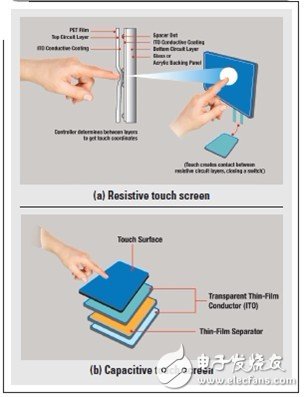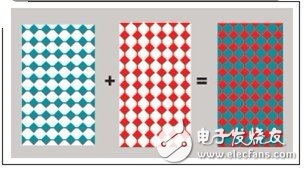introduction
Resistive touch screens have had their heyday, but it is undeniable that they have faded. Obviously, it is more suitable for low-cost design. Users using these designs must wear gloves, for example: in medical, industrial and military environments. However, capacitive touch screens have gained widespread use, and mainstream smartphones and tablets sold on the market today use capacitive touch screens.
Comparison of resistive and capacitive touch screens
Both resistive and capacitive touch screens use indium tin oxide (ITO) sensors, but they are used in very different ways. The resistive touch screen uses the mechanical force of human touch to connect the two flexible layers of ITO (Figure 1a), while the capacitive touch screen control uses: basically, the person itself is a moving capacitor. Touching ITO changes the capacitance level that the system can perceive (Figure 1b).

Figure 1 Comparison of touch screen design
Capacitive touch screens are favored by consumers for two main reasons:
1. The capacitive touch screen uses two layers of TIO, sometimes one layer. It uses a textured sensor similar to a checkerboard (Figure 2), so it can be covered on the LCD with a whole piece, resulting in a clearer and translucent screen.
2. Since the capacitive touch screen control uses the electrolytic capacitor method to achieve detection, the safety glass layer can be placed on the top layer to achieve sealing, which is different from the polyurethane flexible layer of the resistive screen. It also brings a more durable design to users.

Figure 2 TIO rows and columns overlap to form a complete sensor sheet
Capacitive touch screen design considerations
The designers of capacitive touch screens face three main problems: power consumption, noise control and gesture recognition. The rest of this article will explain you one by one.
Power consumption
With so many battery-powered devices today, power consumption is one of the key system issues we need to consider. Devices such as TI's TSC3060 are designed according to low power consumption requirements. Under standard operating conditions, its power consumption is less than 60mA. When detecting touch behavior, its power consumption can be as low as 11 µA. In the same working state, it is at least an order of magnitude lower than its competitors.
Many solutions on the market were originally designed as microcontrollers, and then gradually developed into capacitive touch screen controllers. Designed as a capacitive touchscreen controller from the beginning, there is no extra hardware that consumes extra current and clock cycles. Most systems already have a main central processor, which can be a digital signal processor, a microprocessor, or a microcontroller unit (MCU). So why add another engine to a system that has been fine-tuned? TSC3060 is a special design without a microcontroller.
Noise control
If the controller is unable to distinguish between actual touch and potential sources of interference, not to mention the long battery life. The main noise source of the touch screen usually comes from the LCD, which ultimately depends on the trade-off between quality and cost. AC public ground LCDs are generally cheaper, but have higher noise levels. The DC common ground LCD has DC shielding, which can reduce noise, but will increase costs.
A typical method that can help reduce the amount of noise that the ITO sensor and touch screen controller can perceive is to maintain a certain air gap between the LCD and ITO. This can leave a certain distance between the two, thereby reducing mutual interference. Another way to deal with noise is to use filters. For example, TSC3060 contains a set of programmable mixed signal filters that can be used to reduce noise. These filters are installed into the hardware via an integrated MCU. This means that they can complete tasks nearby faster than using software filters. Quick response to actual touch coordinates can also reduce total system resource consumption.
Gesture Recognition
The last design issue is gesture recognition. Gestures are not necessarily large, complex waves. The gesture can be a simple finger swipe. The system host MCU can easily recognize some simple gestures, such as: pinch, pull, zoom, rotate, double-click and triple combo, etc., and can perform "internal" processing. Adding a dedicated engine may reduce the system MCU bandwidth processing load a little, but it will increase power consumption. In addition, the dedicated engine is used to complete the proprietary algorithm of gesture recognition, which designers cannot see. TSC3060 and other devices push this kind of work to the existing main processor in the system, allowing designers to develop their own royalty-free algorithms freely.
in conclusion
This article compares the functions and advantages of resistive and capacitive touch screen controllers, and explains why the latter is becoming more popular. The article also introduces the reader to the three main considerations when designing a touch screen controller, namely power consumption, noise control and gesture recognition, and gives some possible solutions.
Magnetic Switch,Magnetic Reed Switch,Magnetic Door Switch,Magnetic Contact Switch
NINGBO SANCO ELECTRONICS CO., LTD. , https://www.sancobuzzer.com